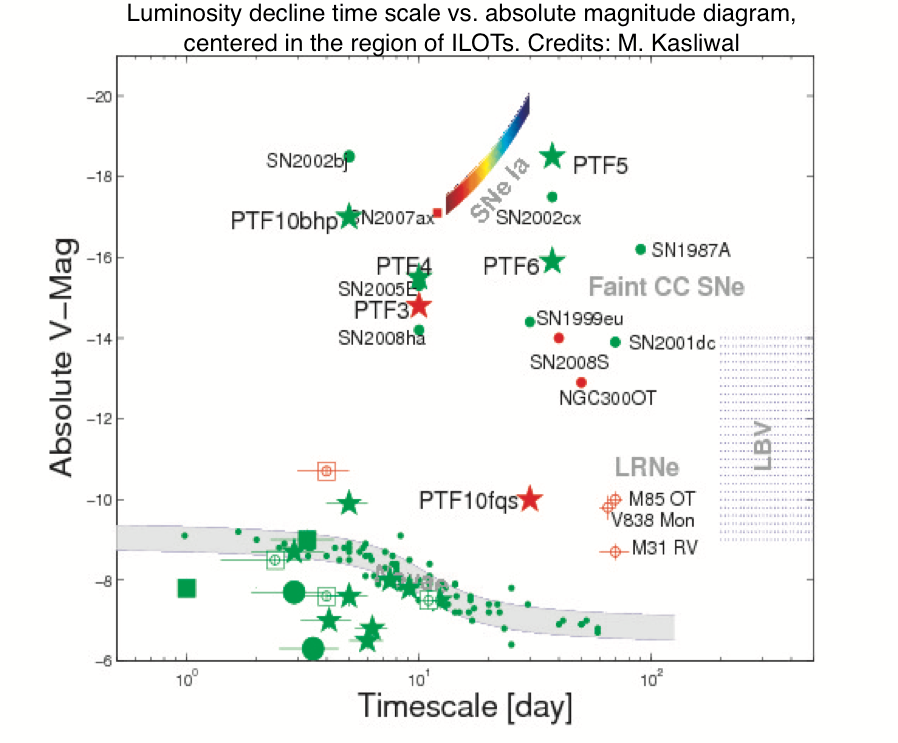 Modern sky surveys are discovering a harvest of novel types of
stellar transients that cannot be explained with traditional explosion
channels. Their number expected to dramatically increase in the
Rubin Observatory's Legacy Survey of Space and Time
(LSST) era. The LSST will discover objects
soon after the outburst onset and will provide well-sampled multi-band
light curves through both the main and ancillary surveys. Thanks to
the multiple survey strategies, we will discover and monitor
transients in different time domains, and we will study transients
evolving with different time scales.
Modern sky surveys are discovering a harvest of novel types of
stellar transients that cannot be explained with traditional explosion
channels. Their number expected to dramatically increase in the
Rubin Observatory's Legacy Survey of Space and Time
(LSST) era. The LSST will discover objects
soon after the outburst onset and will provide well-sampled multi-band
light curves through both the main and ancillary surveys. Thanks to
the multiple survey strategies, we will discover and monitor
transients in different time domains, and we will study transients
evolving with different time scales.
One of the research fields that will largely take advantage from the LSST
is that of the Gap Transients (e.g., Kasliwal 2013, IAUS, 281, 9).
These transients, with absolute magnitudes intermediate between
core-collapse supernovae (SNe) and classical novae (-10 > MV > -15 mag),
are challenging our observational and theoretical knowledge of stellar evolution.
Our team is interested in the study of Gap Transients showing observational evidence of interaction with
circum-stellar material (Pastorello & Fraser 2019, Nature Astronomy, 3, 676, for a review; see also Cai et al. 2022, Universe, 8, 493).
The main goal of this project is the characterization of the different
types of interacting Gap Transients on the basis of their observed parameters
(long-duration photometric monitoring, spectroscopic evolution of the
outbursts, and information on the quiescent progenitors through the
analysis of high spatial resolution pre- and post-outburst images).
In this project, the following classes of non-interacting Gap Transients will not be
considered: low-luminosity stripped-envelopes SNe (SNe Iax, Ca-rich
transients, .Ia candidates, or other faint SNe I; e.g. Kasliwal 2012, ApJ, 755, 161;
Valenti et al. 2009, Nature, 459, 674; Tomasella et al. 2020, MNRAS, 496, 1132 ), and
low-luminosity Type II-P events (Pastorello et al. 2004, MNRAS, 347,
74; Spiro et al. 2014, MNRAS, 439, 2873, Reguitti et al. 2021, MNRAS, 501, 1059; see information
on the Faint SN project).
We will study in detail the following categories:
- Intermediate-Luminosity Red Transients (ILRTs)
- Giant outbursts and eruptions of very massive stars
- Ordinary S Dor LBV phases
- Luminous Red Novae (LRN) and other types of non-degenerate stellar mergers
People directly involved in this project:
Andrea Pastorello (INAF-OAPd), Elena Mason (INAF-OATs), Yongzhi Cai (Tsinghua University), Giorgio Valerin (Padova University, INAF-OAPd), Leonardo Tartaglia (INAF-OAA), Nancy Elias-Rosa (INAF-OAPd), Andrea Reguitti (INAF-OAPd), Giuliano Pignata (Universidad Andres Bello), Enrico Cappellaro (INAF-OAPd).
Other collaborators:
Morgan Fraser (University College Dublin), Paolo Ochner (Padova University), Kuntal Misra (ARIES), Maria Teresa Botticella (INAF-OACn), Paolo Mazzali (Liverpool University), Erkki Kankare, Rubina Kotak, Thomas Reynolds & Shane Moran (University of Turku), Maximilian Stritzinger (Aarhus University), Antonia Morales-Garoffolo (Universidad de Cadiz), Elena Barsukova (SAO, Russian Academy of Sciences), Vitaly Goranskij (SAI, Moskov University), and the Padova-Asiago Supernova Group.